The new shark species emerging from the deep
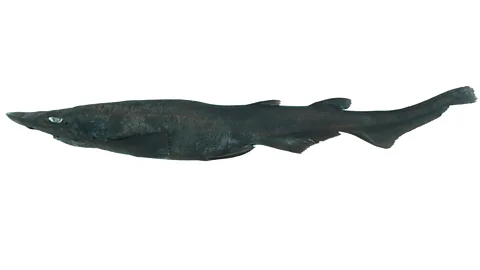 CSIRO Australian National Fish Collection
CSIRO Australian National Fish CollectionMore and more new species of sharks are being discovered as humanity peers deeper into the oceans.
It was a mystery that began with an egg. In 1989, scientists in Australia found a curious kind of "mermaid's purse" – a leathery egg case, which some species of sharks lay instead of giving birth to live young. The empty egg cases had one almost unique feature – a row of prominent ridges along the top.
The eggs had been found off the Rowley Shoals, a group of atolls on the edge of a continental shelf in the East Timor Sea, a few hundred kilometres off the north-eastern coast of Australia. They offered up more questions than they did answers. What had laid them? Where did it live? And why did its egg cases have such a distinctive appearance?
It would be more than 30 years before scientists would finally find out the most basic of these questions – and in doing so discover a completely new shark species.
More than two decades into the 21st Century, humanity is still finding new species of the ocean's most impressive hunters. As recently as the mid-1980s, science had settled on around 360 species of shark, ranging from deep sea featherweights like the 20cm (8in)-long dwarf lanternshark to the enormous plankton-feeding whale shark, the largest species of fish in the oceans.
But in little more than 40 years this number has jumped by nearly 40%. There are more than 500 known species, and the numbers of new species show no signs of dropping off. In September 2024, a new species of ghost shark – a primitive cartilaginous fish closely related to sharks – was identified thanks to the discovery of a specimen fished from the deep ocean off the east coast of New Zealand.
You might also like:
This new wave of discovery rivals that of the golden ages of exploration. It is as much a by-product of painstaking work in the archives of museum collections as it is peering into the deep waters of the world's oceans.
Take the shark that laid the mysterious ridged egg cases, for instance.
Will White, the senior curator of Australian National Fish Collection at CSIRO (Commonwealth Scientific and Industrial Research Organisation) in Hobart, Australia, was part of the team that connected the dots. After being discovered during a survey at Rowley Shoals, the egg cases had been disseminated to museum archives without anyone looking much further into the cases' strange ridges.
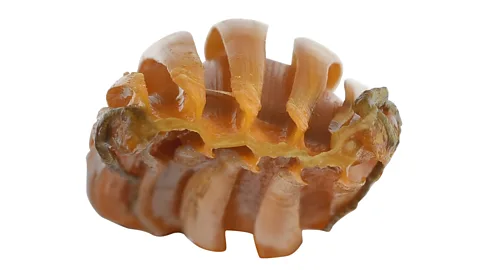 CSIRO Australian National Fish Collection
CSIRO Australian National Fish CollectionIn 2011, a researcher called Brett Human was volunteering at the Western Australian Museum in Perth, when he came across the ridged shark egg case. While it was similar to eggs laid by another species of shark, that animal had never been found in Australian waters. Human linked the egg case to other eggs which had been found off Australia, and narrowed down the species to possibly being a member of the catshark family. But he could not determine the exact species.
"He first described the case and did a very good effort of trying to narrow down… he did a lot better than what a lot of people would have, actually," says White. "Nothing happened on that until we started looking at a case with a colleague Helen O'Neill. Even then I was like, 'I think I'm barking up the wrong tree, looking at cases. No one's really done it, there's probably a reason why'."
It turned out that CSIRO had also been sent examples of the egg cases in the 1980s – and no-one had done further research. "It wasn't until I started looking at the collection data that I realised they're actually from the same surveys. It was collected from the same location on the same day."
White and his colleagues knew the eggs recovered in the 1980s had come from a certain depth – between 410m (1,345ft) and 504m (1,640ft) – and started looking for sharks which had been caught at the same depth. The CSIRO collection had what was thought to have been a South China catshark, which turned out to have been pregnant when it was caught. The scientists dissected it and found a developing embryo inside an egg case with the same tell-tale ridges as the ones discovered years before in Rowley Shoals. The detective work proved it was a completely new species, and the mystery that Australian shark scientists had been scratching their heads over for the last 30 years was finally solved.
 CSIRO Australian National Fish Collection
CSIRO Australian National Fish Collection"It took us, like, two days to work it out," says White. "The thing is, you've got to be looking specifically for it. The adults of that group, in particular, are very subtly different," he says.
The species now has a scientific name (a common name is due to follow), and was unveiled in the Journal of Fish Biology in April 2023. This new variety of demon catshark, otherwise known as Apristurus ovicorrugatus, is thought to dwell around 700m (2,297ft) beneath the surface, laying its egg cases over coral in water too deep for sunlight to penetrate. White says this family of sharks is particularly hard to research because they are so elusive and because the differences between species can be so subtle.
"With this group, in particular, we're actually down into looking at aspects of the digestive tract and liver shape and stuff like that. You're definitely getting desperate when you start getting into characters like that," White says.
He says the current experts on this group of sharks all "liaise with each other and talk with each other" because identifying new species can be such a challenge. "The other thing, unfortunately, is you do get some specimens in collections that all you got is the fixed [preserved] specimen, you don't actually have a fresh photo; that demon catshark we described was lucky because we had a fresh photo as well."
The demon catshark was not the only discovery White had a part in identifying recently. Another species, a type of horn shark, was caught in surprisingly deep waters off Western Australia in a survey last year. Horn sharks tend to like living in shallow waters, often sitting on the seafloor in kelp forests, but this new species was found at 150m (500ft).
But that's nothing compared to what may lie ahead, White says. The demon catshark is not the only new catshark species to have turned up. "We've actually found another new species of that same genus, also with ridged egg cases, but different ridged egg cases off Queensland. So we're working on that now," he says.
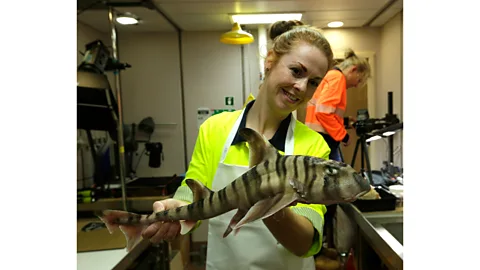 CSIRO Australian National Fish Collection
CSIRO Australian National Fish Collection"I've got a feeling there's another one from Queensland, it's new, from the same genus. And I think there's another one in Western Australia, it's either new or it's a new record of a species poorly known from elsewhere in the world," says White.
The waters around Australia aren't the only ones offering up new shark species. On the other side of the Indian Ocean, German shark scientist Simon Weigmann of the Elasmobranch Research Laboratory in Hamburg helped to discover two new species of saw shark – bizarre-looking creatures armed with long snouts, or rostrums, studded with sharp teeth – off the south-eastern coast of Africa.
The saw sharks were found with the help of a colleague Ruth Leeney from the Anderson Cabot Centre for Ocean Life, who had been researching new species of the related sawfish off the coast of Madagascar (sawfish are a type of ray, distantly related to sharks.)
One of her colleagues called her because fisherman had preserved for her two rostra, of what they thought were sawfish," Weigmann says. "And when she saw the photos, she immediately recognised, these were not sawfish, but saw-sharks, which is also very interesting finding because saw-sharks are not caught all day long."
The saw-sharks had some interesting details: instead of the five gill slits most sharks possess, they had six – an evolutionary echo from much older shark species that lived millions of years ago. They also had small fleshy tendrils known as barbels far closer to the tip of the rostrum than is found in other species of saw-sharks.
To confirm his hunch this might be a new species, Weigmann travelled to London's Natural History Museum, which has a saw shark caught more than 100 years ago which is in remarkably good condition. "It was quite clear that the barbels are close to the mouth, as had been described for that species," says Weigmann, referring to the Natural History Museum's example. Whatever Lenney's colleague had photographed in a fish market in Madagascar, it looked like it was a new species. Further research from specimens in other collections in South Africa also seemed to support this.
Then another shark researcher – Andrew Temple from the King Abdullah University of Science and Technology in Saudi Arabia – got in touch. "We had found a saw shark off Zanzibar in Tanzania, where they made a survey for the local fisherman's landings, even different from the ones that we had just found," says Weigmann. "So we said, 'Okay, maybe it's just an unusual specimen. Or maybe it's even a second new species,'" he says.
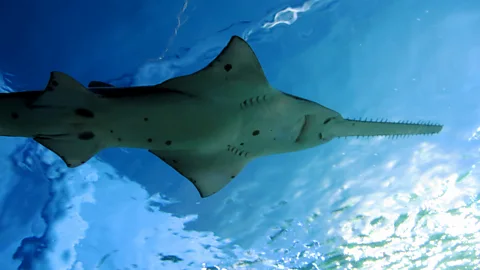 Getty Images
Getty Images"It's very special because saw sharks are not common and you only have few species." Weigmann adds another relevant point: "They look very cool."
It was not scientists like Weigmann who had first noticed there was something different, however – it was the Madagascan fishermen who had caught them. "It was really important that we had the local fishermen providing this material. If they had not collected the rostra, or later landed the specimens that were picked up in Zanzibar, we would not have noticed. I would not have tried to examine all the other museum materials, I would just have not noticed that there is something different."
Many of the saw sharks that have been discovered so far live relatively far down in the ocean – as deep as 300m (1,000ft) – but the species off Zanzibar was caught less than 30m (100ft) from the surface. "We think that they might have come to shallower depth for the night, which is typical for many groups of marine organisms," says Weigmann.
"I think it's the biggest movement of animals in the word, this vertical movement that you have in the oceans at night. There are also many sharks known to exhibit vertical movements. So I think during day they might occur deeper, but we do not know because we only have them from this depth. And that makes them even more vulnerable to [commercial] fishery," says Weigmann.
There is much more to this discovery than an addition to the known species in a reference book, or a new display in a museum. Weigmann uses the example of the blue skate, a type of ray from the North Atlantic that was relatively common until commercial fishing decimated its numbers. "The populations collapsed," he says. "And then, about 10 years ago, some scientists even noticed that there were two species lumped under this name. So all the fisheries statistics that you had population status, you could not work with anymore because you could not know was it the one species or the other species. And that makes taxonomic research and describing new species so important," he says.
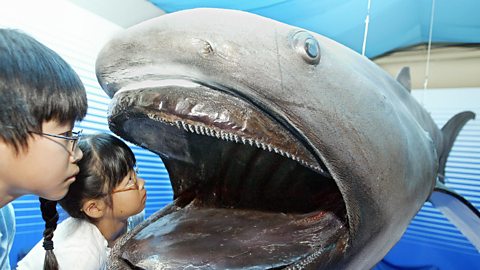 Getty Images
Getty ImagesMore sharks may yet be waiting to be discovered in the deep, and not all of them may be as small as the metre-long catsharks awaiting classification. In 2021, scientists discovered three new species of deep-sea sharks that glow in the dark, including one that can grow up to 1.8m (5.9ft).
It is also less than 50 years since researchers discovered a strange shark tangled in the sea anchor of a US Navy ship off Hawaii. The shark in question was nearly 15ft-long (4.5m) and a species that had never been seen before – a filter-feeder that swam with its jaws agape. A shark scientist called Leighton Taylor dubbed it the "megamouth" shark; the species is now considered to be one of the largest-growing species to be found today.
What else may be waiting for shark scientists, far below the ocean surface?
* This article was originally published on 12 July 2023. It was updated on 24 September 2024 to include details of a new species of ghost shark – or spookfish – discovered off the coast of New Zealand.
--
